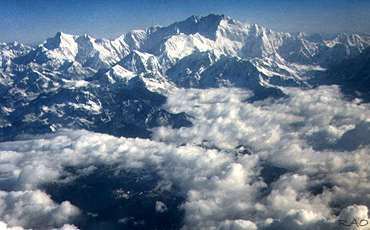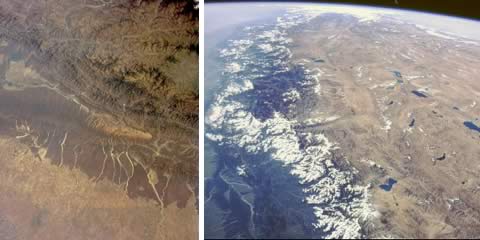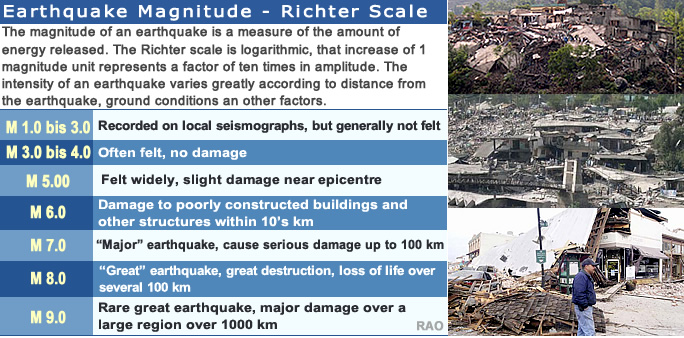 |
| Earthquakes in Nepal |
|
|
|
|
|
 |
|
|
| 'Inevitable' Himalayan earthquake will threaten 50 million |
 |
|
The researchers have been forced to reach a very undesirable conclusion.
The american research team is not able precisely predict when a massive earthquake would occur, but they think, that it could be "very soon" in geologic terms. A massive earthquake must occur to relieve the seismic strain that earthquake has hit that area in hundreds of years.
| A massive earthquake will probably occur along the edge of the Himalayan mountains |
The plate carrying India is slowly slipping under the Asian plate. This is what caused the rise of the Himalayan Mountains and is the source of great seismic strain along the mountain range. This increasing strain has put about two-thirds of the mountain front in "a perilous condition." Some small earthquakes in the past 200 years have relieved some of the seismic strain along about a third of the front.
About
50 million people live in the areas at risk of a massive earthquake and
many live in buildings that offer little resistance tocollapse from earthquake
action. In 1905, an earthquake struck Kangra, an Indian town, and caused
about 19,000 deaths. If a similar earthquake hit the same town now.
According to the researchers from the Bolder University, the Indian plate is slipping under the Asian plate at the rate of about 1.8 meters (six feet) a century along the entire front. This amounts to an area the size of about 10 soccer fields a year moving under the Asian plate. The strain that results from such movement is like a spring being pulled tighter and tighter. They know the inevitable outcome. The lock holding the spring will break. A giant earthquake is the only solution to have theseplates unzip and slide.
There have been no great earthquakes in the area for about 500 years, but geological evidence shows that they have happened in the past. A massive earthquake in the area could cause thousands of casualties. The population there has soared and the construction practices are suspect. The combination we could bring a really bad situation. Most earthquake deaths result from the collapse of buildings, trapping victims under brick, steel and wood. The "Big Earthquake" could be omorrow, the next day or perhaps the next century. It was passing through Arunachal Pradesh, the Mikir hills, Shillong plateau, and moving towards Nepal and Pakistan.

|
|
As a result of the collision that started more than 65 million years ago, the average elevation of the Tibetan Plateau in the intermountain valleys is approximately 4880 meters.
| Source: Nepal Red Cross Society, November 2008 |
| images: NASA |
|
Nepal |
| Earthquakes: Richter Scale |
 |
| MODIFIED MERCALLI INTENSITY SCALE |
| ESTIMATED INTENSITY | PERCEIVED SHAKING | POTENTIAL DAMAGE |
| I II-III IV V VI VII VIII IX X |
Not Felt Weak Light Moderate Strong Very Strong Severe Violent Extreme |
None None None Very Light Light Moderate Moderate/Heavy Heavy Very Heavy |
| I | People do not feel any earth movement. |
| II | Felt by persons at rest, on upper floors of tall buildings |
| III | Felt by people indoors.
Hanging objects swing back and forth.
May not be recognized as an earthquake. |
| IV | Hanging objects swing.Vibration may seem like the passing of heavy trucks or a jolt, like a heavy ball striking the walls.
Parked vehicles may rock noticeably. Windows, dishes, doors may rattle and glasses clink. In the upper range of IV, walls of wood frame buildings may creak. |
| V | Almost everyone feels movement whether inside or outdoors.
Sleeping people are awakened. Liquids in containers are disturbed; some are spilled.Small unstable objects are displaced or overturned. Doors swing, close, or open.Shutters, pictures on the wall move. |
| VI | Felt by all; some are frightened and take cover.
People have difficulty walking due to motion. Objects fall from shelves and dishes, glassware and ceramics may be broken. Pictures fall off walls. Furniture moves or is overturned.Weak plaster and masonry cracked. Damage slight in poorly constructed buildings. Trees, bushes shaken visibly or are heard rustling. |
| VII | People have difficulty standing. Drivers on the road feel their cars shaking. Furniture may be overturned and broken. Loose bricks fall from buildings and masonry walls and cracks in plaster and masonry may appear. Weak chimneys may break at the roofline. Damage is slight to moderate in well-built structures; considerable in poorly constructed buildings and facilities. |
| VIII | Drivers have trouble steering.
Tall structures such as towers, monuments and chimneys may twist and fall. Wood frame houses that are not bolted to their foundations may shift and sustain serious damage. Damage is slight to moderate in well-constructed buildings, considerable in poorly constructed buildings. Branches are broken and fall from trees. Changes occur in flow or temperature of springs and wells. Cracks appear in wet ground and on steep slopes. |
| IX | Masonry structures and poorly constructed buildings suffer serious damage or collapse.
Frame structures, if not bolted, shift off foundations. Serious damage to reservoirs.Underground pipes broken.
|
| X | Most masonry and frame structures destroyed along with their foundations.
Some well-built wooden structures and bridges are destroyed.Serious damage to dams, dikes, and embankments. Large landslides occur. Water thrown on the banks of canals, rivers and lakes. Sand and mud shift horizontally on beaches and flat land. Rails bent. |
| Contributed by United States Geological Survey (USGS), 2009 |
|
|
|
Nepal |
| Links |
| External Links |
|
|
|
|
Nepal |
|
|
|
|